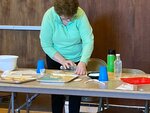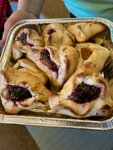

On Sunday, March 17, children from the Jewish Center of the Moriches worked alongside their parents to prepare hamantaschen, the traditional three-cornered Purim pastry filled with poppy seeds or sweet jam.
According to rabbi Margie Cella, Purim, celebrated this year on Saturday, March 23, through Sunday, March 24, is a joyous holiday to commemorate the efforts of Esther, an ancient Queen of Persia, to empower her people to defend themselves against the efforts of Haman, an evil prime minister who tried to annihilate them.
Like Passover, which occurs four weeks later, Purim is a reminder that freedom is precious. It includes tasks, foods, readings, and activities that foster connection to congregants’ faith and community.
As the religious leader of the Moriches Jewish community, Rabbi Cella finds activities like preparing the hamantaschen useful, both to forge connections within a family and to teach valuable religious lessons that preserve traditions. Here, the children’s participation making hamantaschen is part of their religious instruction.
Rabbi Cella explained that since Israelis began as farmers in the desert, many of their traditions involve food. Each holiday has specific foods included, except Yom Kippur, which is about fasting and atonement.
For Purim, there is a reading of the Book of Esther with its detailed story of Haman’s plot against the Jews, Esther’s cousin Mordechai’s exhortations that she act, and her successful campaign to bring about her people’s deliverance. Traditionally, one gives money to at least two poor individuals, gifts of food to others, and participates in a festive feast that includes wine and costumes, symbolic of Esther’s initial need to hide her Jewish identity before Haman’s defeat.
The food preparation for Purim is also preparation for the more extensive food making that is an integral part of Passover.
Recounted in the Book of Exodus, the first half of the story describes the Egyptian enslavement of the Jews. The Seder, a meal to observe the first night of Passover, draws from commandments to the people as they are liberated: to eat unleavened bread; to make a sacrifice on the first night; and to prepare and consume a meal. The rituals continue as a reminder to successive generations of the hardships faced and the deliverance that followed.
The Seder plate’s six spaces each hold a symbol: bitter herbs represent slavery; the mixture of fruit and seeds, the mortar used for brick making, part of the toil of enslavement; a green vegetable dipped in salt water is the hope of renewal mixed with tears; a shank bone symbolic of a ritual sacrifice; a roasted egg, the rebirth in freedom. The meal includes four cups of wine to drink in joy, and matzoh, the unleavened bread.
In her explanation of the traditions, Rabbi Cella was quick to point out the themes that connect both holidays: freedom is precious; tasks empower people; empowered people can deliver themselves from oppression. And, as an educator as well as spiritual leader, her choice to use the hamantaschen as an opportunity for instruction was met with grace and humor among the participants.
Looking down at a plate of cooling pastry, a rueful Tracy Koison, shook his head.
“We’re going to have to practice at home,” he sighed.
Comments
No comments on this item Please log in to comment by clicking here